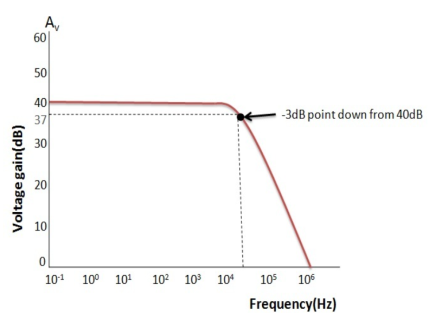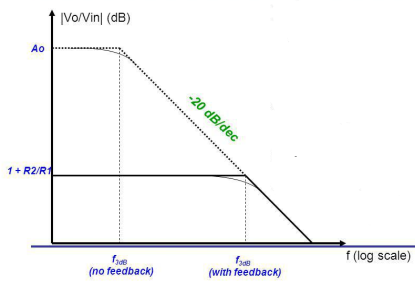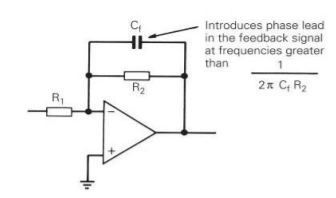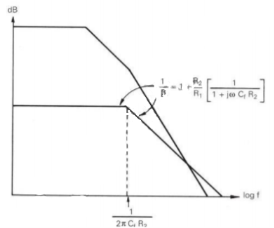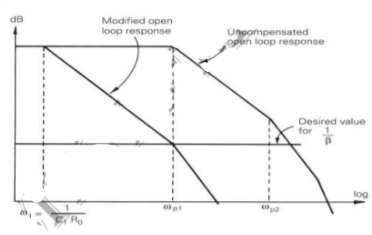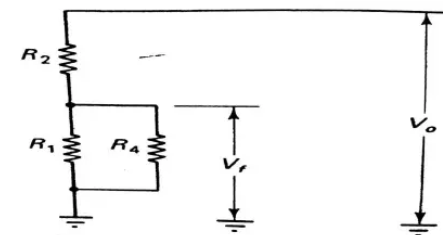|
AOL (f) = V0/Vin if Vf = 0 ----- (1) where AOL (f) = open loop volt gains. The closed loop gain Af is given by AF = V0/Vin = AOL / (1+(AOL) (B) ----(2) B = gain of feedback circuit. B is a constant if the feedback circuit uses only resistive components. |
 , the system is stable. However, some systems the magnitude may never be 0, in that cases method 2, must be used.Method 2:Determine the phase angle when the magnitude of (AOL) (B) is 0dB (or) 1.If phase angle is > - 180
, the system is stable. However, some systems the magnitude may never be 0, in that cases method 2, must be used.Method 2:Determine the phase angle when the magnitude of (AOL) (B) is 0dB (or) 1.If phase angle is > - 180 , If the magnitude is –ve decibels then the system is stable. However, some systems the phase angle of a system may reach -1800, under such conditions method 1 must be used to determine the system stability. Q2) Explain frequency and phase response?A2)
, If the magnitude is –ve decibels then the system is stable. However, some systems the phase angle of a system may reach -1800, under such conditions method 1 must be used to determine the system stability. Q2) Explain frequency and phase response?A2)
|
GBP = Gain x Bandwidth = A x BW For example, from the graph above the gain of the amplifier at 100kHz is given as 20dB or 10, then the gain bandwidth product is calculated as: GBP = A x BW = 10 x 100,000Hz = 1,000,000. Similarly, the operational amplifiers gain at 1kHz = 60dB or 1000, therefore the GBP is given as: GBP = A x BW = 1,000 x 1,000Hz = 1,000,000. The Voltage Gain (AV) of the operational amplifier can be found using the following formula: Av = Vout/ Vin and in Decibels or (dB) is given as: 20 log (A) or 20 log (Vout/ Vin ) in dB |
|
Using the formula 20 log (A), we can calculate the bandwidth of the amplifier as: 37 = 20 log (A) therefore, A = anti-log (37 /20) = 70.8 GBP/ A = Bandwidth, therefore, 1,000,000 / 70.8 = 14,124Hz, or 14kHz Then the bandwidth of the amplifier at a gain of 40dB is given as 14kHz as previously predicted from the graph. |
|
|
|
|
 CfR2 the capacitor introduces a phase lead in the feedback fraction, which approaches 90S. If Cf is chosen so that the frequency 1/2
CfR2 the capacitor introduces a phase lead in the feedback fraction, which approaches 90S. If Cf is chosen so that the frequency 1/2 CfR2 is a decade below the frequency at which open-loop response plots intersect, a phase margin of approximately 90S is obtained. Use of a lead capacitor in parallel with a feedback resistor is a convenient way of getting extra phase margin. It is also a technique that can be used to overcome the effect of stray capacitance between the op-amp’s inverting input and earth.Shunting a signal point with a capacitor resistor combination (a lag network) is an alternative technique that allows wider closed-loop bandwidths. At frequencies above 1/2
CfR2 is a decade below the frequency at which open-loop response plots intersect, a phase margin of approximately 90S is obtained. Use of a lead capacitor in parallel with a feedback resistor is a convenient way of getting extra phase margin. It is also a technique that can be used to overcome the effect of stray capacitance between the op-amp’s inverting input and earth.Shunting a signal point with a capacitor resistor combination (a lag network) is an alternative technique that allows wider closed-loop bandwidths. At frequencies above 1/2 C1R1 (the break-back frequency) a network of this kind produces an attenuation R1/(R1||Ro) but the phase shift returns to zero.
C1R1 (the break-back frequency) a network of this kind produces an attenuation R1/(R1||Ro) but the phase shift returns to zero.
|
|
|
 =1. The feedback network changed by Zin Mod is shown below.
=1. The feedback network changed by Zin Mod is shown below.
|
|
When R4 is considered the feedback factor in the circuit becomes
The gain of op-amp is
The voltage gains for inverting amplifier is
Without R4 and C4 the gain of amplifier is Av = 1/
|


